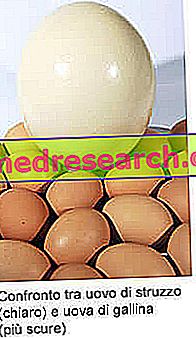What are
Ostrich eggs ( Struthio camelus ) are foods of animal origin TYPICAL of Africa; the most important farms are located in the center and south of the black continent, but their distribution is now almost ubiquitous.

Ostrich eggs are not only a valuable nutritional source, they have acquired a certain religious meaning, symbolic paganism and practical utensils.
Fertilized eggs?
It is important to emphasize that ostrich eggs, despite their considerable size and nutritional value (similar to that of chicken eggs), are NOT ALWAYS used for DIRECT human nutrition.
As much as each ostrich egg corresponds to about 20-30 of a hen, an adult ostrich (whose meat is consumed and feathers and skin are used) has a total mass of 150kg, so well over 100 times the small Gallus gallus (hen). This yield is clearly lower than that guaranteed by poultry farming, has led breeders to direct production towards the slaughter animal rather than on the oviparous front.
Ostrich eggs are, like those ordinarily consumed (of hen, quail, goose, duck, turkey, guinea fowl etc.), the female cells (gametes) of the animal. It follows that the edibility of the ostrich egg also depends (and above all) on any fertilization and hatching time (or incubation) after laying; in fact it would be inappropriate to consume ostrich eggs containing the embryo being developed, not so much due to hygienic reasons, but rather to a factor of aesthetic taste. This clarification is not obvious; the reader might think "God forbid anything other than the chick!" And yet, what not everyone suspects is that ostrich farms (for obvious reasons, being intended for the reproduction of animals for slaughter) are NOT differentiated between males and females.
Where to buy them
Ostrich eggs can be purchased in a short supply chain, directly from the aviculturist; needless to point out that, as regards the aforementioned in the previous paragraph, it is necessary that he enjoy a certain reliability and professionalism, in order to avoid the possibility of presenting the famous "inconvenience".
In the kitchen
Now let's talk about "how" to consume ostrich eggs, both in methodological terms (breaking the shell) and in gastronomic terms.
How to break the shell
First of all, we point out that ostrich eggs weigh up to and over 1.5kg (like an adult hen); obviously, manipulating a similar food can only be quite complicated.
The outer calcium shell is a few millimeters thick and its resistance is proverbial to say the least; DO NOT try to break it on the rim of the bowl or make the omelette with the shards of the container!
The recommended methods are two, one that preserves the integrity of the shell and one that does not allow it.
- Without preserving the shell: place the egg in a bowl (plastic!) And with the use of a small hammer, with one or more decisive strokes, crush it to drain the contents outside. NB : Take care to analyze the liquid and clean it from the residues of the shell before cooking it, otherwise the dental integrity of the guests
- Preserving the shell: stabilize the egg in a plastic container and, with the use of a drill, pierce a vertex (progressively increasing the diameter of the hole) obtaining a passage of about one centimeter in diameter; repeat on the opposite side (blocking the first hole with your finger to avoid pouring it onto the work surface). At this point it is sufficient to drain the contents into a separate container, blowing into the upper hole in order to facilitate the escape of the liquid. NB : However desirable the preservation of the shell may be, remember that by drilling the shell it is inevitable that some small fragments, and certainly very fine dust, fall inside the egg polluting the liquid. It is advisable to filter everything by means of a Chinese sieve.
Recipes with Ostrich Eggs
The gastronomic destination of ostrich eggs is the same as any other bird's egg. It is perfect in the formulation of omelettes, it excels when used in mixtures and creams MA requires cooking times to say the least ample when consumed hard (from 100 to 140 ', depending on the size).
Nutritional Properties
Also the nutritional properties of ostrich eggs do not differ from those of chicken eggs; it is a food rich in proteins with maximum biological value, cholesterol, lecithins, vitamins (especially riboflavin or vit. B2 and retinol equivalent, in particular β-carotene) and mineral salts (especially iron). The predominant amino acids are likely to be ac. glutamic acid, ac. aspartic and leucine, while the saturated fatty acids prevail. Ostrich eggs are rich in water, around 75-80% of the total.



